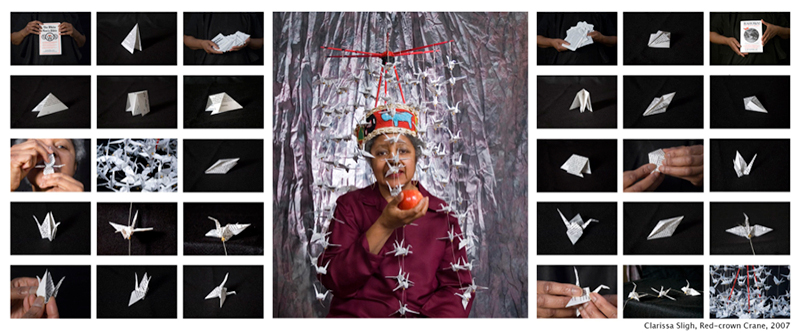Speaking Volumes: Transforming Hate
Art
The sign in front of the Speaking Volumes: Transforming Hate exhibition leads with words by Dr. Martin Luther King Jr.: “Returning violence for violence multiplies violence, adding deeper darkness to a night already devoid of stars …” This quote is from Strength to Love, an evergreen collection from 1963 about religious values, specifically of love and the power of earnest human compassion. These texts weren’t meant to be topical, but King wrote several while jailed for holding a prayer vigil. King’s words of nonviolence, compassion and humanism set the tone for the way the pieces at the Springville Museum of Art process hatred, creating new political and social implications. The exhibition has been accumulating pieces since the last decade, and so their brand of engaging white nationalism has an uneasy translation into 2018, when white supremacy is mainstream. Some pieces seemed to age poorly while others felt fresh, but with each piece, I was invariably having a conversation with myself about race and white nationalism that I clearly needed to have.
I went to Speaking Volumes with my partner, who consistently had different initial reactions to pieces. The premise of the show is built off a racist text from the ’70s: In 2004, a defecting leader of the “Creativity Movement” provided the Montana Human Rights Network 4,000 copies of its primary text, which was the religious group’s “bible”—white supremacist dreck. Though not every single piece uses the text as its base, most do as either a jumping-off point or an opportunity to literally reform the pages. Clarissa Sligh uses the text in “Red Crowned Crane” (2007), in which dozens of hanging cranes, constructed from the defector’s text, surround her. Sligh says, “As an African American artist, I could not turn down the invitation to create an artwork that would respond to these books.” Sligh processes the existence of this drivel and gives it a new physical form. “I learned to turn the pages of the books into origami cranes,” she writes. “My fingers were stiff and clumsy. My folds were irregular, imprecise. But I continued folding.”
More challenging was Jane Waggoner Deschner’s “The Way Things Go, and Don’t” (2007), which felt aged. Below Sligh and her cranes is a table of several copies of the white supremacist bible propped up vertically, each wearing a custom-knit hat. “Reading the words of the white supremacists, I could never make sense of their hatred,” writes Deschner. “But I can show compassion for them as fellow human beings and transform their words into something that speaks differently.” This sat poorly with me and felt odd even for a decade ago—humanizing white nationalists feels like straight bad praxis. (The hats seemed well-made.) My partner pointed out that oppressive views wouldn’t stamp themselves out. Oppression would never die that way. We talked about our position as white people and agreed that it was our job to engage white nationalists who argue on a good-faith basis—if they would reciprocate. I realized from Deschner that you knit when it’s productive. You bring together the people you can, because that’s earnest human compassion, and you don’t begrudge any oppressed person of explaining why they’d rather not.
Throughout, we were having this discussion and engaging with each other’s political reactions to certain pieces as well as our emotional responses. I was grateful for the space to do this, especially because I was so back and forth on what I was thinking. I hated the late Jim Riswold’s “Himmler’s Homework” (2005) and “The Hitlermobile” (2006). Both are toy reincarnations of Hitler and his head SS officer. At first, I enjoyed how reductive it was to infantilize Hitler, but I paused at the description. “Every evil dictator worth his salt has a sweet ride. Adolf Hitler was no exception.” Suddenly, it felt kitschy and weirdly sentimental, something I don’t harbor for anti-semitism or its imagery.
Faith Ringgold’s “Hate is a Sin Fem Fable” (2007) is a creation fable for the first time she was called the N-word. In it, a white man’s son begins to bear resemblance to “Negroids,” and as he casts his own son out, the boy tells his father, “I love you … but now my blood is on your hands.” Ringgold’s piece is opportunity for healing. “Illegal Alien’s Guide to Critical Theory” (2007) works through the ways U.S. immigration policy is inherently dehumanizing. Enrique Chagoya’s lithograph shows a person lying down as red and white squares tumble from his head—below him stereotypes of immigrants repeat shallow rhetoric on the effect of immigration. Across from these sits Robbie McClaran’s 1990s photograph of Timothy McVeigh, the Oklahoma City bomber. McVeigh’s face, though imprisoned in orange and white, is so smug. He looks pleased with the attention, and my partner and I wondered if a face as pathetic as his deserved space in the exhibition against powerfully uplifting pieces like Ringgold’s. The difference may be in whether we are watching the artist process hate or whether we are being asked to do so—or both.
There are so many more works by so many more artists from marginalized communities here. This is political, personal and requires you to confront yourself. It’s hard, and it’s a space we should all try to live in more earnestly. Speaking Volumes: Transforming Hate runs until June 2 at the Springville Museum of Art. Find more information at smofa.org.

